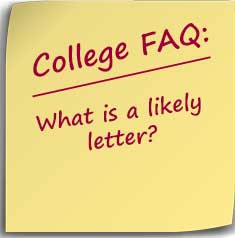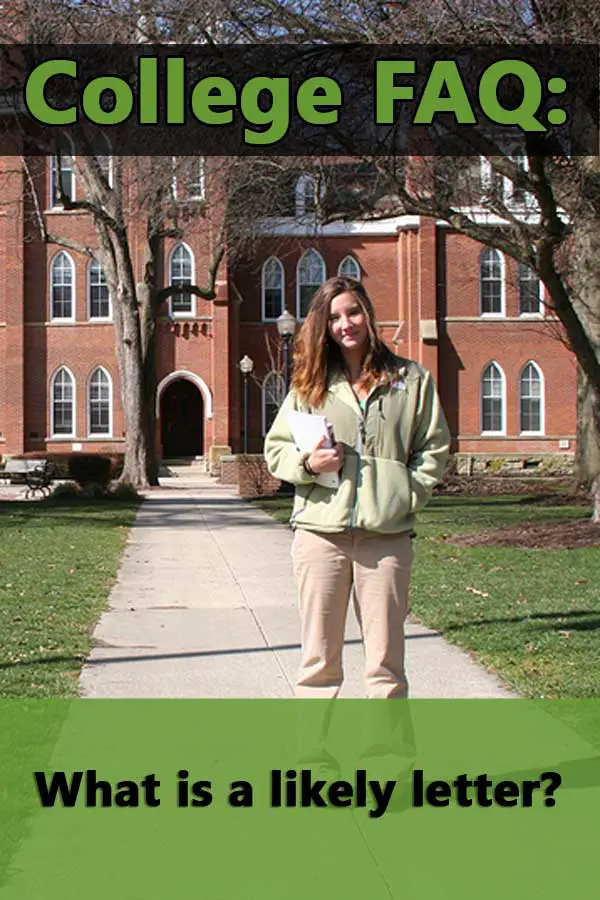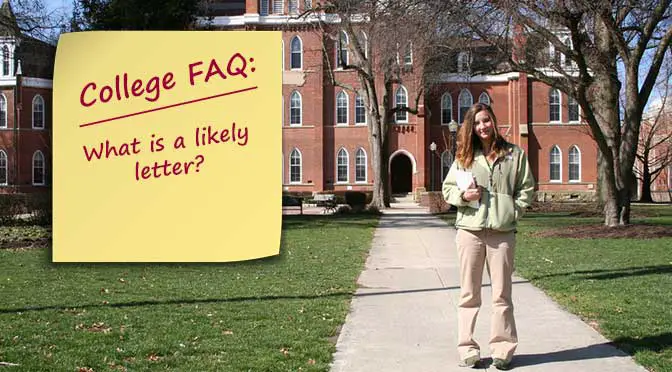 A “likely letter” is a letter from the college admissions office stating that you are likely to be admitted as long as nothing changes before the official admissions deadline. They are not formal offers of admissions–just notices that students are very “likely” to be admitted. Students receive likely letters a month or two before the regular admissions decision deadline.
A “likely letter” is a letter from the college admissions office stating that you are likely to be admitted as long as nothing changes before the official admissions deadline. They are not formal offers of admissions–just notices that students are very “likely” to be admitted. Students receive likely letters a month or two before the regular admissions decision deadline.
Likely letters are common for athletic recruits to the Ivy League. Since Ivy League schools don’t award athletic scholarships, they use likely letters as a means to indicate to the athlete that they will be accepted at the school. The Ivy Manual allows Likely Letters to be sent out after October 1st and they must come from the admissions office (pg 146).
Click HERE for List of Hardest Colleges to Get Into PDF
Although the Ivies compete at the D1 level, without scholarships, there isn’t a National Letter of Intent for athletes to sign on National Signing Day. The Likely Letters are the only means Ivy League schools have to let athlete’s know that they have a spot for them on the team. According to Tier One Athletics, “it varies from between sports and schools, but 2/3 to 3/4 of the varsity athletes in the Ivy League are Likely Letter recruits.”
Likely Letters for non-Athletes
However, based on the manual, it’s clear that athletes aren’t the only ones to receive likely letters. The Ivy Manual states that institutions can send likely letters to candidates “whether or not the applicant is a recruited athlete.” You can also find similar information on the Dartmouth website:
A “likely letter” informs a student that their application has been reviewed and the probability of acceptance is high. All Ivy institutions use a small number of likely letters as a way to reassure highly recruited athletes and other outstanding applicants. Most students do not receive likely letters; it’s not the usual path to an acceptance. But if you get one, athlete or not, congratulations are in order!
According to the Harvard Crimson, the admissions office sent out 300 likely letters in 2011 and 100 of them were addressed to non-athletes. Instead of offering these students early admissions, they receive likely letters. At Brown, approximately 1/5 of the class receives likely letters with about half sent to athletes.
The letters are a way to let applicants know they have a place waiting for them before official acceptance letters are released. Likely letters can be an important way for these schools to keep the students from committing to other schools that send out acceptance letters, and generous financial aid awards, earlier. The Harvard Crimson quotes the College Dean of Admissions and Financial Aid William R. Fitzsimmons:
“They’re also usually likely to be people who are receiving admissions as they go along from other places, or versions of likely letters,” Fitzsimmons said. “A lot of places, public and private, have so-called merit awards that they give special incentives.”
“Our feeling is we don’t do merit scholarships, and we don’t have those kinds of incentives, where we see somebody like that we can send the likely as a signal,” he added.
The Yale Dean of Undergraduate Admissions informed it’s Alumni Schools Committee that
The Yale Admissions Office sends “likely letters” only to those applicants who have received an early review and who we believe are exceptionally strong as scholars, student-athletes, or contributors in other areas of special interest to the Yale community, including music and the arts. We believe that a number of other competitive colleges and universities will also be actively recruiting these stellar students.
This is why some students may receive likely letters before even completing an ASC interview. Business Insider discussion of likely letters echoes this strategy, “But colleges who send out Likely Letters also do so for their own interests, as they are competing against other schools to land accepted applicants on their campus, according to Taylor.”
Given that the schools are targeting those who they believe are the cream of the crop, it’s not surprising to hear of students who have received more than one likely letter. Martin Altenburg received three, Victor Agbafe collected them from “most” of the Ivies, Brandi Moore from four of the Ivies, and Amaris Lewis from Harvard and Yale.
It’s not just Ivy League schools that send out likely letters. The University of Virginia also sends out likely letters. Other schools that send out versions of the likely letter are Smith, Clark, and Grinnell. You can see some of the schools that have offered likely letters to students on places like the ApplyingToCollege subreddit.
Basically, competitive schools use likely letters for non-athletes who they can’t offer admissions to before their agreed upon deadline. Furthermore, these schools aren’t interested in using a rolling admissions system since they want to make sure they have seen all applicants before offering admissions. Therefore, the group of non-athletes who receive likely letters is going to consist of a small, elite group that matches the school’s priorities. Even the most competitive schools are willing to do some specific marketing to get the students they want.
The important thing to remember is that the vast majority of non-athletes admitted to these schools do not get a likely letter. There isn’t anything that students can do to “get” one beyond what they have already submitted in their application.



2 thoughts on “FAQ: What is a likely letter?”